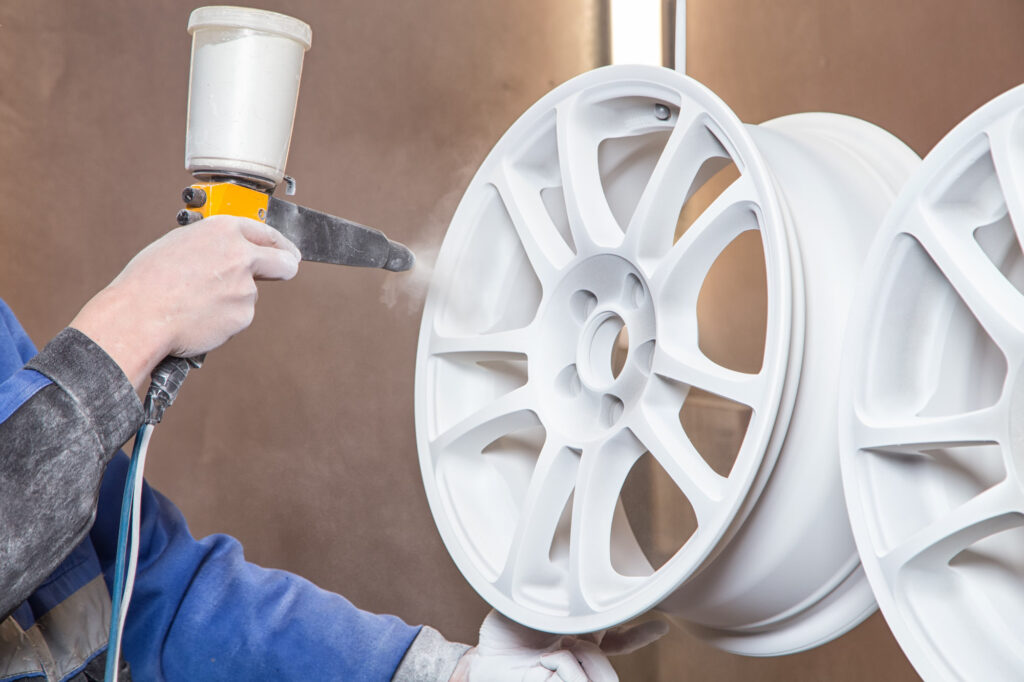Dry finishing is a process in textile manufacturing that uses mechanical or chemical treatments to improve the look of various surfaces. One such process is powder coating, which has been around since the mid-40s.
What Is Powder Coating?
Powder coating is a dry finishing process used as a functional, protective, and decorative finish. It uses polymer resin systems combined with curatives, pigments, leveling agents, flow modifiers, and other additives.
The ingredients are ground and mixed to create a uniform powder. Afterward, a spray gun is used to apply an electrostatic charge to the powder particles.
Different Types of Powder Coating

There are a handful of powder coating types based on the powders used, features, and application. The common ones are epoxies, polyesters, super durable polyesters, urethanes, and fluoropolymers.
Epoxies
Epoxies were the first powders used for powder coating. Compared to other types, they’re more robust and have the best chemical and corrosion resistance, thanks to their molecular structure. They also stick to metal better, producing good adherence.
Epoxy is also more flexible, which means it can be applied to non-vehicle components, such as medical equipment, devices, filters, and furniture.
One disadvantage of epoxy powders is their long-term effect. They’re prone to fading and chalking due to sun exposure, leaving a disintegrated finish after a few months.
Polyesters
On the other hand, polyesters are the most commonly used material for powder coatings. They have excellent mechanical properties, giving way to high flexibility and impact resistance. This powder also cures at low temperatures, making it ideal for heat-sensitive surfaces.
Another advantage of polyesters is their overbake resistance to yellowing, which generates one to three years’ worth of UV resistance. This makes polyesters perfect for wheels and other exterior applications. Lastly, they’re known for being the most cost-effective option because they simplify the spray deposition process.
Super Durable Polyesters
Super-durable polyesters are a step up from the normal variant. They keep their color and gloss within specified limitations for 5 to 10 years longer than normal polyester.
Super-durable polyesters also have enhanced humidity and corrosion resistance. They give wheels a consistent glossy finish, perfect for those who want a clean look. All these factors combined make super-durable polyesters perfect for warm places like California.
Urethane
Urethanes are similar to polyesters, with the main difference being their curing agents. Curing agents are the substances that react with the resin to form a cross-linked network.
Urethanes leave behind a smooth finish, are durable, and have excellent chemical and corrosion resistance. They also offer better protection for outdoor applications, making them perfect for wheel coverage. On top of that, dirt and grime are less visible on urethane-coated materials.
One disadvantage of urethane is it becomes brittle at greater thicknesses. It’s also more expensive compared to epoxy, which provides similar attributes. Urethanes are also notorious for producing smoke during application, making them bad for the environment.
Fluoropolymers
Fluoropolymers aren’t commonly used on wheels, as they’re better suited in the architectural sector because of their weatherability and color/gloss retention. There are two types of fluoropolymers: FEVE and PVDF.
FEVE resins are more popular because they can be bonded, leaving an evenly dispersed metallic flake throughout the powder. On the other hand, PVDF fluoropolymers require a primer beneath them, making them difficult to bind when making metallic powders.
How to Powder Coat Wheels
Powder coating is a tedious process that can have stunning results. If you’d like to powder coat your wheels on your own, here are the things that you need to have on hand:
- Sandblasting cabinet
- Powdering coating gun
- Powdering coating oven
- Powder coating powder
- Metal or wire hanger
- Goggles and gloves
Once you’ve prepared the necessary items and equipment, follow the steps below:
- Step 1: Wear your safety goggles and gloves. Wash the wheels and sand out any blemishes to have a clean surface to work with.
- Step 2: Sandblast the wheels completely around the outer edges of the rim. Go over every area to remove all the paint and clear coat before powder coating.
- Step 3: Hang the wheel in a well-ventilated booth and cover its front and back with powder using the powder coating gun. Don’t apply to the area covered by the tire to avoid wasting materials.
- Step 4: Place the wheel in the oven preheated to 400 degrees F. It should take around 20 minutes to cure, but ensure you check the label for specific times.
- Step 5: Let the wheel cool off.
Pros and Cons of Powder Coating Wheels
Powder coating has its advantages and disadvantages, much like any finishing process.
| Advantages | Disadvantages |
| Different finishes can be achievedAn added layer of protection against corrosion, scratches, and fadingEconomical, durable, and long-lastingConsistent color finishProduces thicker coatings than liquid coatingsNon-toxic and less flammable | Can leave an orange peel textureCan be expensive due to the materials neededPowders can’t be mixed to get different colors |
How Much Does It Cost to Powder Coat Wheels?
It costs somewhere between $350 and $700 to powder coat wheels. There are a ton of factors that go into play to determine the final bill.
These include the size of the rims, quality of powder coating, professional cost, and the amount of prep work that goes into the process.
There are also DIY kits you can buy for a little over $100, but they seldom offer a clean finish, unlike professional powder coatings.
Should I Powder Coat My Wheels?
While the pros of powder coating outweigh its cons, it’s up to you whether to take the plunge . Powder coating is relatively expensive compared to other options, but there’s no doubt the finish will give your ride’s look an upgrade.
Get Protective Gear for Your Next DIY Task
When buying materials for your powder coating job, don’t forget to include a pair of safety goggles, work gloves, and other protective gear.
Some powder coats can contain small amounts of lead, which can cause health issues if you aren’t careful. For your safety, it’s best to invest in high-quality protective gear that can protect you from the fumes. Thankfully, you can easily get them from CarParts.com.
At CarParts.com, you’ll find a wide selection of protective gear, such as safety glasses, face masks, and work gloves. The best part is that you don’t have to wait too long for your order to arrive. If you order by 12 PM ET, you can expect your new safety equipment to arrive in as fast as two business days! Paired with our easy-to-navigate website, shopping has never been easier.
Don’t wait until you damage your skin or hurt your eyes before investing in the right protective gear. Check out our catalog of safety glasses, face masks, and work gloves at CarParts.com, and get a pair for yourself today!
Any information provided on this Website is for informational purposes only and is not intended to replace consultation with a professional mechanic. The accuracy and timeliness of the information may change from the time of publication.






































